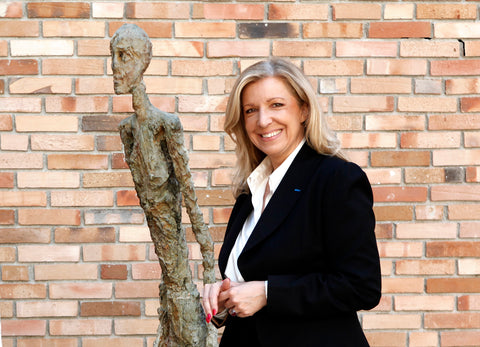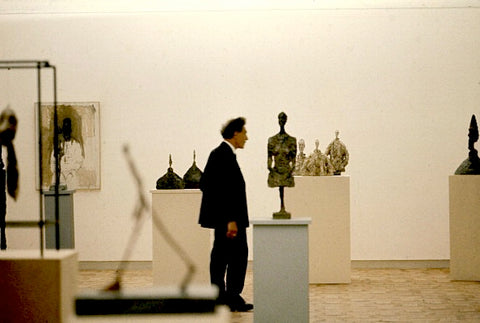.Giacometti - Biography
Alberto Giacometti is one of the most important artists of the twentieth century. Becoming famous thanks to his sculptures, he was also a renowned painter and designer. Although he was already one of the leading figures of the surrealist movement in Paris in the 1930s, it was his post-war creations that became his major artistic legacy. The long, slender statues embody Giacometti's easily recognizable style. The representation of the human being in his vulnerability and his existential anguish constitute the main subject of his creation. For Giacometti, it was about grasping reality in all its complexity.
His father, Giovanni Giacometti, himself a painter, encouraged him to take an interest in sculpture. At the end of his compulsory schools, Alberto left to study at the Geneva School of Fine Arts before arriving in Paris on January 9, 1922. He attended Antoine Bourdelle's studio at the Grande Chaumière academy in Montparnasse. . He discovered Cubism, African art and Greek statuary.
With his brother, Diego Giacometti, he moved in April 1927 on rue Hippolyte-Maindron (14th arrondissement) into “the cave-workshop” which they never left. The same year, Alberto exhibited his first works at the Salon des Tuileries.
His first personal exhibition at the Galerie Maeght took place in 1951, it was accompanied, like those that followed, by the edition of Derrière Le Miroir, including original lithographs.
Giacometti's lithographs are pure line drawings executed in black on transfer paper. We find there the familiar or insistent subjects to which his painted and sculpted work has accustomed us, the same characters, the same street, the same workshops cluttered with sculptures, stools and paintings. The rapid, nervous, repeated line does not surround or fix the forms but seems to make beings and things emerge from the very light which bathes them and from the space which they develop.
If the conditions of the process, notably the impossibility of erasing or returning to the line, give lithographs less finesse and less subtlety than graphite drawings, they on the other hand acquire a frankness and spontaneity which allows , in a way, to witness the birth, the emergence of his hallucinating drawing.
Among the iconic photographs of Henri Cartier-Bresson there is this marvel, both an exceptional document and a living portrait of Alberto Giacometti. It was taken during the preparation of an exhibition at the Maeght Gallery, in 1961. "The Walking Man" was exhibited there before joining the courtyard of the Maeght Foundation which was under construction.
The etchings engraved in 1955 are also aids to drawing but, in this area, the imperative requirements of the process give the compositions very particular characters. Alberto Giacometti cares very little for complex techniques, for the “cooking” of etching, he willingly abandons the rest of the operations, from biting the metal to printing the proofs. He engraves with the point on the copper varnish as he would do with a feather on a sheet of paper.
In his engravings, Alberto Giacometti invites us into his workshop, sharing with us his research and the progress of his sculpted or painted work. In the clutter of Buste in the workshop, we see canvases, placed against the wall, sculptures completed or in progress.
“I will never be able to put into a portrait all the strength that is in a head. » he writes. When Alberto Giacometti makes portraits, he lets us create the environment as in the artist's wonderful portrait Mother in which he only represents the face. Our imagination builds around this face. Conversely, for Bust of a Man, Head of a Man and Bust II, the artist highlights the facial features and places them in an environment, even going so far as to create a frame for Head of a Man. The Dog and Cat's Head seem to respond to each other across the studio under The Walking Man, tireless walker through pictorial time. Giacometti has fixed, in his engraved work, some of his sculpted or painted masterpieces in the middle of everyday objects The Workshop with two buckets, The Two stools, the stove, a harness... Alberto Giacometti says again : “There is nothing more than reality that interests me and I know that I could spend the rest of my life copying a chair. »

Few color photos of Alberto Giacometti.
This one, from 1958, is by Ernst Scheidegger, it’s a pure masterpiece.
We recognize the iconic sculptures that my grandfather, Aimé Maeght, intended for the Maeght Foundation which was then under construction.
Born October 10, 1901 in Borgonovo, Switzerland.
Died on January 11, 1966 in Chur, Switzerland.
"And when, at the twilight of his research, he liked to cover with color the craters of the blind plaster, was he on the threshold of an unknown color, or should we see in this little barbaric red and blue that 'an even more abrupt relief for the white of absolute mourning?'
Yves Bonnefoy, “The Stranger by Giacometti”.
1915-1919 : Completed his secondary education at the Protestant college of Schiers, near Chur, in Switzerland. First sculpted or painted busts and first wood engravings. Interrupts his studies and enrolls at the École des Beaux-Arts, then at the École des Arts et Métiers in Geneva. One-year trip to Italy.
1922 : Moves to Paris to study sculpture. Attended the Académie de la Grande Chaumière, in the workshop of the sculptor Bourdelle.
1925 : First participation at the Salon des Tuileries where he exhibited a Head of Diego and an avant-garde work ( Torso ).
1926 : Installation at 46 rue Hippolyte-Maindron, in Paris in what will definitely remain his workshop. Created a series of sculptures of heads and figures ( The Couple , The Spoon Woman ).
1927 : Exhibited at the Salon des Tuileries
1929 : Thanks to Jean Cocteau, he rubs shoulders with social circles. Devoted himself to painting and sculpture, while designing decorative objects for the interior designer Jean-Michel Frank and jewelry for the fashion designer Elsa Schiaparelli.
1930 : Joins the Surrealist group, an artistic movement founded by the writer André Breton. Exhibited at the Pierre Loeb Gallery in Paris, alongside Jean Arp and Joan Miró. He acquired great “surrealist” notoriety with The Suspended Ball. Meets Louis Aragon, André Breton, Salvador Dalí, André Masson... His brother Diego joins him in Paris.
1932 : Collaborates and participates in the Salon des Surindépendants.
1935: First personal exhibition in New York, Galerie Julien Levy. The Invisible Object , masterpiece of Giacometti's surrealist era. Is excluded from the Surrealist group. These new sculptures of almost abstract geometric rigor bring him back to reality and the model ( The Cube, Head ).
1936 to 1940 : Participates in numerous group exhibitions around the world. Frequents the artists Balthus, Gruber, Tal Coat, and the group around the journal Abstraction-Création. Frequents André Derain, to whom he has real admiration. Entrusted the New York gallery owner, Pierre Matisse, with the representation of his work in the United States. Leave the model behind and return to memory work. His sculptures become tiny until they disappear.
1941: Befriends Simone de Beauvoir and Jean-Paul Sartre. During the war, lived in Geneva with his brother Diego.
1945: Resumes sculpture of nudes and heads, determined not to let them diminish; but he destroys them and starts them again to end up with the same stretched and filiform figures, the only ones to correspond to his vision of reality.
1935 to 1947 : Does not exhibit once.
1947 : Participates in the International Surrealism exhibition at the Maeght Gallery. Aimé Maeght commissioned his first bronze sculptures from him.
1948 : First personal exhibition at the Galerie Pierre Matisse in New York. Jean-Paul Sartre writes the preface to the catalog. His style is now asserted. Sculpts The Standing Woman, Three Men Walking, Figurine in a Box, The Square, The Forest, The Clearing.
1949 : First lithograph, the portrait of the poet Tristan Tzara. Wife Annette Arm.
1951 : First personal exhibition at the Galerie Maeght in Paris, where other exhibitions followed in 1954, 1957 and 1961 . Creates lithographs for Derrière le Miroir, a magazine published by Maeght. Francis Ponge devotes an essay to him in the magazine Cahiers d'art , illustrated with photographs by Ernst Scheidegger.
1953-1954 : Designs the sets for his friend Samuel Beckett's play “Waiting for Godot”. The writer Jean Genet poses for him. Jean-Paul Sartre devotes a second essay to him, published in the magazine Derrière le Miroir .
1956 : Works on a series of large Standing Woman which he exhibits at the Venice Biennale in the French pavilion ( Les Femmes de Venise ). He exhibits at the Kunsthalle in Bern. In October, Isaku Yanaihara, professor of French philosophy at Osaka University, began to pose for him. He returned to pose in 1957, 1959, 1960 and 1961.
1957 : Jean Genet writes "L'Atelier d'Alberto Giacometti", which appears in the magazine Derrière le Miroir, then in the form of a book illustrated with photographs by Ernst Scheidegger in 1963.
1958 : First monographic exhibition in Japan, in Tokyo, at the Minami Gallery. Befriends Caroline, who poses for him from 1960 to 1965.
1959 : Architect Gordon Bunshaft commissioned a monument for the Chase Manhattan Bank in New York. This work absorbed him for a year until the spring of 1960. Giacometti imagined a walking man, a standing woman and a head on a pedestal which summed up for him all his research, the project would not be carried out. While the Maeght Foundation project is well advanced, Aimé Maeght offers Alberto Giacometti a space worthy of his work by offering him the opportunity to occupy the central courtyard of the Maeght Foundation. Four of these sculptures will be painted by the sculptor and placed by him in the Foundation Courtyard.
1960 : Giacometti pursues an impossible resemblance, notably in the busts of Annette and the paintings of Caroline. He concentrates on the design of the eye and the intensity of the gaze which seems to him to command the truth of the whole head.
1961 : Publication of the book by Michel Leiris “Vivantes ashes innommées” illustrated with 52 etchings. Wins the Carnegie Sculpture Grand Prize in Pittsburgh.
1962: International guest of the Venice Biennale, he won the Grand Prize for sculpture. Maeght Editeur publishes the first complete monograph of Alberto Giacometti under the artist's control.
1964: Inauguration on July 28, 1964 of the courtyard and the Giacometti room at the Marguerite and Aimé Maeght Foundation in Saint-Paul, where his work is very widely represented. Receives the Guggenheim International Painting Prize, awarded by the Solomon R. Guggenheim Museum in New York. The photographer Eli Lotar began posing for busts until 1965. He produced a very large number of lithographs for the album “Paris sans fin”. Ernst Scheidegger shoots a film on Giacometti in the studio on rue Hippolyte-Maidron and in Stampa.
1965: Three retrospectives take him to London (Tate Gallery), New York (Museum of Modern Art) and Copenhagen, Denmark (Louisiana Museum). Receives the Grand Prix National des Arts, awarded by the French Ministry of Cultural Affairs.
On January 11, 1966, died of cardiac exhaustion at the hospital in Chur, Switzerland. Alberto Giacometti was buried on January 15 at the Borgonovo cemetery, Switzerland.

Yoyo Maeght in the Giacometti Court at the Maeght Foundation, near the bronze of the Walking Man.
In 2010, Yoyo Maeght organized the exhibition "Giacometti and Maeght - 20 years of friendship" which remains the exhibition of all records at the Maeght Foundation in Saint-Paul-de-Vence.
The book La Saga Maeght by Yoyo Maeght, with dedication. Link here
blfon blgia




 Aimé Maeght, Annette Giacometti, X, Marguerite Maeght, Alberto Giacometti in the Giacometti Court at the Maeght Foundation, 1964.
Aimé Maeght, Annette Giacometti, X, Marguerite Maeght, Alberto Giacometti in the Giacometti Court at the Maeght Foundation, 1964.


